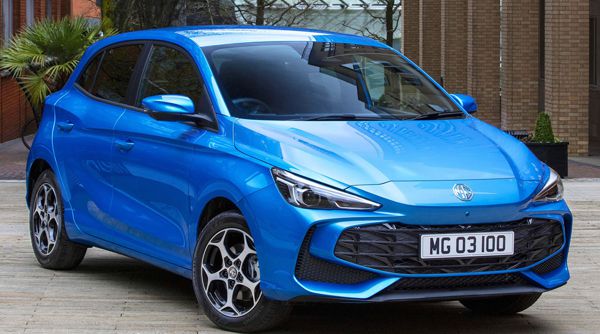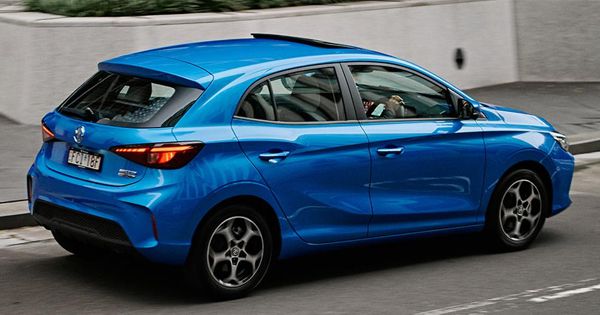Published
on 15
Jul 2025
|
All rights reserved.
|
|

|
|
Affordable
Chinese supermini returns with a punchy hybrid option.
|
|
5 years ago it was hard to
imagine Chinese cars could be competitive in Europe. Things are turning
quickly lately. Not just EVs, Chinese car makers now make also decent
gasoline and hybrid cars, and they usually undercut European, Japanese
or even Korean rivals by a significant margin. MG 3 is a good example.
The MG 3 is not exactly new to European motorists. Back in 2013 the
first generation was already exported to Europe, albeit with little
sales success. Back then, the Chinese-built supermini was designed and
engineered by a British team located at the old Rover site in
Longbridge, UK. I liked its characterful design but not so much about
everything else, namely, performance, handling and refinement.
Fast forward to 2024, the second generation model is a sharp contrast.
This time it doesn’t look very smart, but it drives and works better,
closer to if not quite matches the level of Renault Clio,
Peugeot 208, Seat Ibiza, Skoda Fabia, Volkswagen Polo, Suzuki Swift and
Toyota Yaris. Surprisingly, there is no electric version at all, as the
car is designed to be a cost-effective choice to the majority of
motorists, but it gives you a choice between gasoline engine and
full-hybrid powertrain, very much like Clio and Yaris. Both versions
are cheaper than their rivals, of course.
In my eyes, the new 3 is not as pretty as its predecessor. Its body
involves a lot of curves but they are not arranged coherently. The
clamshell bonnet and pointy nose are set too high, contributing to a
bulky perception not unlike SUVs. At just over 4.1 meters long and
nearly 1.8 meters wide, it is at the larger end of the supermini
segment, yet the 1.5 meters height make it almost as tall as a
crossover. A Renault 5 is equally tall, thanks to its underfloor
battery, but its edgy design and wheels-at-corner stance hide its bulk
a lot better than the jellyfish-like MG 3. Note that the car was
designed in Shanghai studio under the watch of design chief Oleg Son,
whose expertise is in interior design. By contrast, the larger MG 4 was
designed in London studio under Martin Kropp. Maybe this is why the
latter looks so much better!
The interior design is not bad, but you won’t call it classy either.
There are two LCD screens, one is a 7-inch instrument display, another
a respectably large 10.25-inch center touchscreen. MG / SAIC’s
infotainment system is not exactly state of the art. Most people
complain about its unintuitive layout, small icons and tiny text which
make the system hard to operate in a move. Oddly, when you connect to
your smartphone via Apple CarPlay or Android Auto, the climate control
and audio control disappear from the main screen. Likewise, the suite
of safety systems, i.e. blindspot warning, driver monitoring, lane
departure warning and speed limit warning, keeps beeping annoyingly and
is difficult to turn off… MG should have spent more time to sort out
these software glitches.

|
|
Build
quality and refinement still trails European standards.
|
|
Given the extra exterior dimensions, the cabin is not especially
spacious. Still, rear passengers are offered with more legroom than
most
rivals, although headroom is a bit tight for taller guys. On the
downside, the quality of materials, fit and finish are not up to
European standards. All plastics are hard and look cheap. Soft padding
is limited to the “lip” of the dashboard. Driving position is hampered
by a steering wheel lacking reach adjustment. Visibility is not helped
by the swoopy bonnet, which makes it impossible to judge the position
of its nose, and the thick C-pillars. However, considering the car is
priced lower than its rivals, all these are forgivable.
The mechanical side is certainly more promising, even surprising, most
notably for the hybrid version. It uses a 1.5-liter four-cylinder
Atkinson-cycle engine which produces 102 horsepower and is claimed to
achieve a thermal efficiency of 41 percent. It is mated with 2 electric
motors, one for propulsion and one for generation, through a planetary
automatic gearbox. However, unlike Toyota which uses the generator
motor to turn the planetary gearbox into a continuously variable
transmission, this one works just as a 3-speed automatic. The MG’s
propulsion motor is much larger than its rivals’, therefore produces
superior output at 136 hp and 184 lbft. In addition to a larger,
1.83kWh Lithium-ion battery installed under the rear seat, this
theoretically allows the car to run with electric power more the time
and benefit fuel economy.
Another strength is outright performance. The combined output is an
outstanding 194 hp, significantly more than the 143 hp offered by Clio
or 131 hp of Yaris. This allows the MG to quote 0-60 mph in a warm
hatch-like 7.6 seconds. In the real world, it is found even quicker,
easily 2 seconds quicker than its rivals. The acceleration does tail
off at higher speeds, as the electric motor runs out of rev and the
Atkinson-cycle engine struggles to do all the propulsion work, but for
most usage the MG 3 just feels brisk and willing to overtake. The
Chinese seems to have its advantage in EV technology put to good use.
Less remarkable is the refinement of the system. At harder
acceleration, there is a slight but noticeable delay in throttle
response, and the automatic gearbox makes each of its gearchange
slowly, so the power flow is not as seamless as it should have been.
The
calibration of the hybrid system strategy is also not as clever as
Toyota or Renault, resulting in frequent depletion of battery power and
inferior fuel efficiency in real-world testing. The deficits from Yaris
and Clio are not huge, but should have been better considering its
larger share of electric power. Still, it is more frugal than
conventional superminis, while the extra performance is appreciable.

|
|
Body
roll is moderately controlled but hardly anything to be excited about.
|
|
Less convincing is the entry-level 1.5-liter naturally aspirated 4-pot
engine. Despite a claimed 115 horsepower, it feels underpowered to haul
a car that is at the heavy end of the class, feeling strained and
sounding coarse under acceleration. This could be made even worse when
mated with CVT, which is mandatory in some markets. The alternative
5-speed manual is not great either, blame to a long-throw and loose
gearchange.
The chassis was tuned by the UK R&D team for European roads. It is
a compromise between comfort and safe handling. It offers plenty of
stability as the cheap Kumho tires run out of grip quickly and turn the
car into understeer. Body roll is moderately controlled but hardly
anything to be excited about. The steering is light but offers no feel.
The car lacks the agility and driver engagement of the best superminis.
Meanwhile, although the suspension setting is relatively soft, it fails
to match the smooth ride of Renault Clio, Seat Ibiza or Volkswagen
Polo. Refinement also trails European rivals by a good distance, as
both road and wind noises are quite intrusive in the cabin. The MG 3
prefers city commutes than travelling on open country roads.
As seen, the second generation MG 3 still needs more polish to really
match its global rivals. However, many will find the above weaknesses
forgivable when considering its bargain price. A loaded MG 3 is about
10 percent cheaper than its equivalent rivals. This means you can buy
the hybrid model with the same money as its ICE counterparts, enjoying
its superior performance while saving gas bills. I wouldn’t do that,
but certainly some buyers would find that tempting.
|
Verdict:    |
|